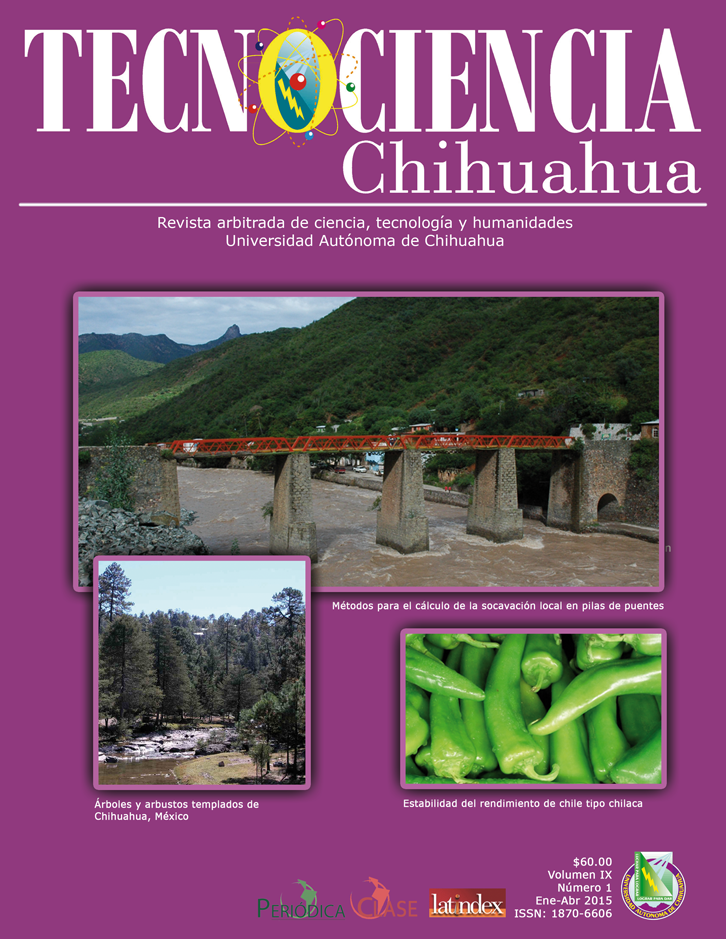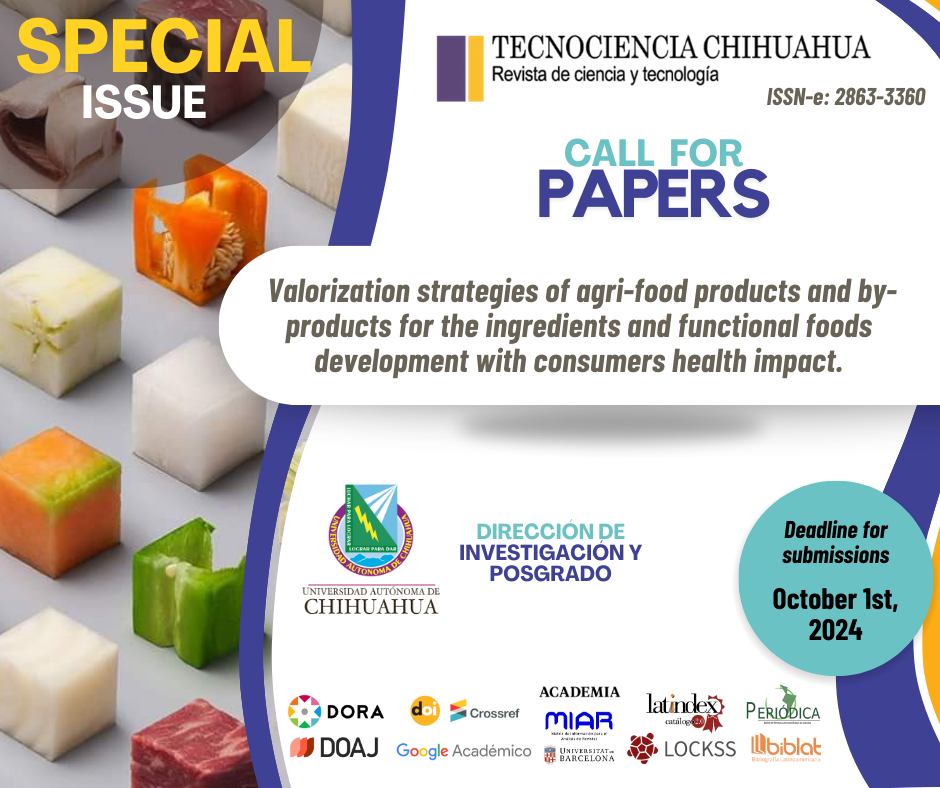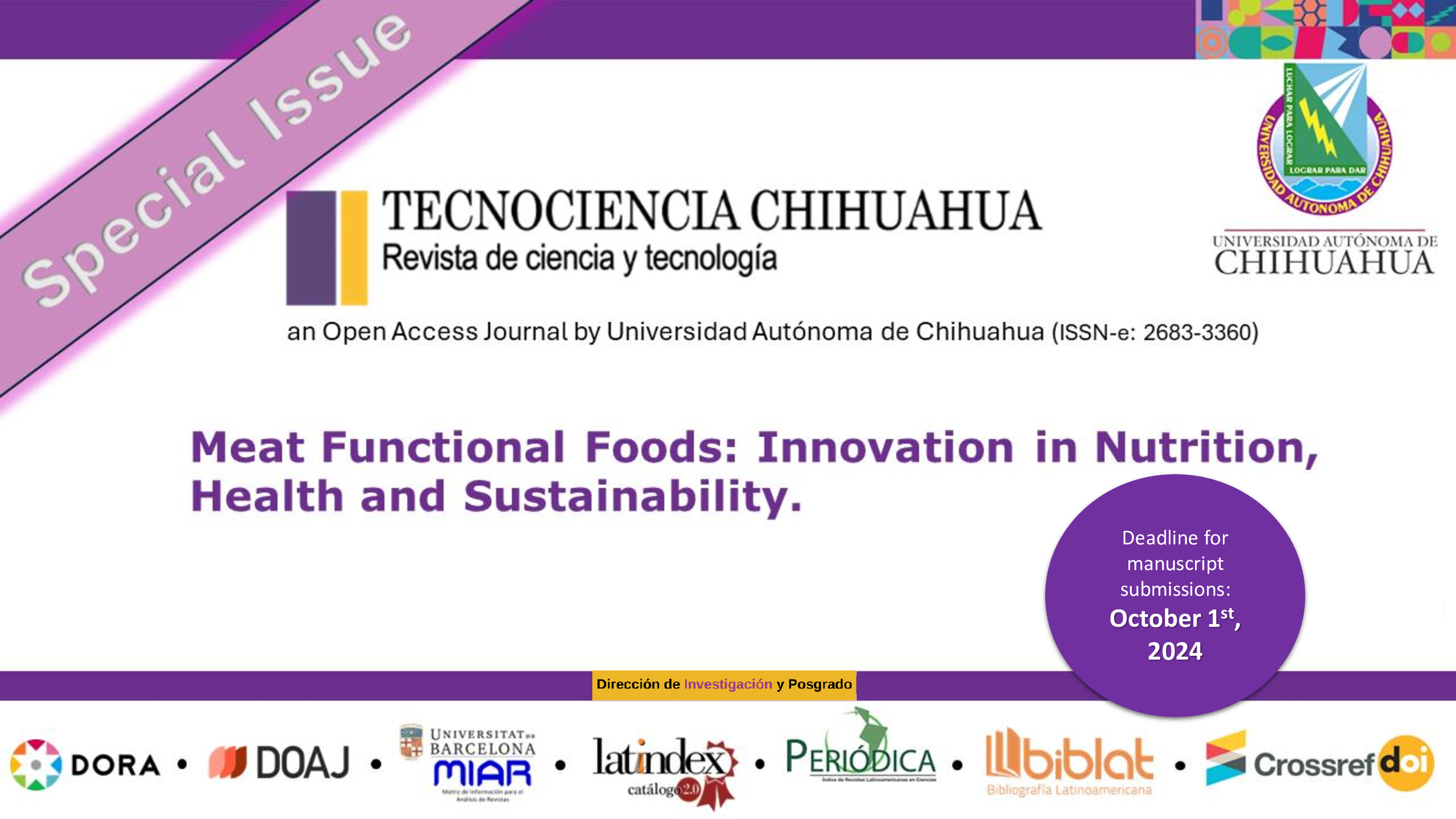Estabilidad del rendimiento de chile tipo chilaca
Yield stability of chile chilaca type
Resumen
Con el propósito de evaluar la estabilidad del rendimiento de ocho variedades de chile chilaca del programa de mejoramiento genético de la Universidad Autónoma de Chihuahua y un testigo de amplio uso estatal, se establecieron seis experimentos en igual número de ambientes de Chihuahua. Se utilizó la técnica propuesta por Eberhart y Russell teniendo como parámetros principales el valor de la pendiente (1) y la desviación de la regresión (Sdi). Los mejores rendimientos se obtuvieron en las localidades del noroeste del estado, lugar de origen de las variedades; los coeficientes de regresión variaron desde 0.285ns (Harana 4), hasta 1.851* (Harana 1), donde Harana 7, 6, 3, 4, 5 y Colegio 64 fueron estables con valores 0.759, 1.168, 0.621, 0.285, 0.772 y 0.464, respectivamente. Sólo Harana 2 resultó consistente ante los cambios de ambiente con Sdi de 0.389. Harana 7 y 6 sobresalieron por su alto rendimiento en todos los ambientes, son estables pero no consistentes. Harana 1 es de alto rendimiento y no estable, se sugiere su siembra en ambientes con índices ambientales superiores a la media general. El único genotipo consistente es Harana 2, de rendimiento intermedio que reúne las características de mercado buscadas por el consumidor final (tamaño, forma y grosor de fruto, picor y sabor).
Abstract
In order to evaluate the stability of the performance of eight varieties of chili chilaca of the genetic improvement program of the “Universidad Autónoma de Chihuahua” and a control state use, six experiments were established in the same amount of environments of Chihuahua. The technique proposed by Eberhart and Russell was used, having as main parameters the value of the slope (1) and the regression standard deviation (Sdi), The best performances were obtained in the northeastern of the state, place of origin of the varieties; the regression coefficients varied from 0.285 ns (Harana 4) to 1.851* (Harana 1), where Harana 7, 6, 3, 4, 5 and Colegio 64 were stable with values of 0.759, 1.168, 0.0621, 0.285, 0.772 and 0.464 respectively. Only Harana 2 resulted consistent on the environment changes with Sdi of 0.389. Harana 7 and 6 excelled for their high performance in all of the environments, they are stable and not consistent. Harana 1 showed high performance and without stability, its sowing in environments superior to the general mean is suggested. The only consistent genotype is Harana 2 with the intermediate performance that gathers the sought market characteristics for the final consumer (size, form and thickness of the fruit, pungency and flavor).
Keywords: Capsicum annuum L., Anaheim, G x A interaction, chilaca, Chihuahua.
Citas
Brancourt-Hulmel M. & C. Lecomte. 2003. Effect of environmental variates on genotype environment interaction of winter wheat: A comparison of biadditive factorial regression to AMMI. Crop Science 43(2):608-617. https://doi.org/10.2135/cropsci2003.6080
Brennan, P. S., D. E. Byth & D.W. Draker, I.H. De Lacy & D.G. Butler. 1981. Determination of the location and number of test environments for a wheat cultivar evaluation program. Australian Journal of Agricultural Research 32(2):189-201. https://doi.org/10.1071/AR9810189
Carballo, C. A. & F. Márquez, 1970. Comparacion de variedades de maíz de El Bajio y la Mesa Central por su rendimiento y estabilidad. Agrociencia 5:129-146.
Crossa, J., H.G. Gauch Jr, & R.W. Zobel. 1990. Additive main effects and multiplicative interaction analysis of two international maize cultivar trails. Crop Science 30(3):493-500. https://doi.org/10.2135/cropsci1990.0011183X003000030003x
Eberhart S. A. & W.A. Russell. 1966. Stability parameters for comparing varieties. Crop Science 6(1):36-46. https://doi.org/10.2135/cropsci1966.0011183X000600010011x
Finlay K. W. & A.A. Wilkinson. 1963. The analysis of adaptation in a plant breeding program. Austr. J. Agric. Res. 14:742-754. https://pdf.usaid.gov/pdf_docs/PNAAS139.pdf
García, E. 1973. Modificaciones al sistema de clasificación climática de Köppen Para adaptarlo a las condiciones de la República Mexicana) Segunda Edición. Instituto de Geografía. UNAM.
Gauch Jr., H. G. 1992. Statistical analysis of regional yield trials: AMMI analysis of factorial designs. Elsevier. ISBN 0444892400, 9780444892409
González G., J. & R. Ozaeta. 2006. Parámetros de estabilidad (S. A. Eberhart and W. Russell). Universidad Autónoma de Chihuahua. Facultad de Ciencias Agrícolas y Forestales. Cd. Delicias, Chih. México. Versión 1.0 en disco compacto.
Gurung, T., S. Techanwongstien, S. Bhalang & S. Techawongstien. 2012. Stability analysis of yield and capsaicinoides content in chili (Capsicum spp.) grown across six environments. Euphytica 187:11-18. https://doi.org/10.1007/s10681-012-0672-6
Hermosillo, M.A., J. González, S.J. Romero, M. Luján, A. Hernández & S. Arévalo. 2008. Relación genética de materiales experimentales de chile tipo chilaca con variedades comerciales. Revista Chapingo Serie Horticultura 14(3):301-307. https://www.scielo.org.mx/scielo.php?script=sci_arttext&pid=S1027-152X2008000300011
Huehn, M. 1990. Nonparametric measures of phenotypic stability. Part 2: Applications. Euphytica 47:195-201. https://doi.org/10.1007/BF00024242
Mandel, J. 1971. A new analysis of variance model for non-additive data. Technometrics 13(1):1-18. https://www.stat.cmu.edu/technometrics/70-79/VOL-13-01/v1301001.pdf
Pérez, D. J., L.M. Vázquez, J. Sahagún & A. Rivera. 2007. Estabilidad del rendimiento de genotipos de papa (Solanum tuberosum L.). Revista Fitotecnia Mexicana 30(3):279-284. https://doi.org/10.35196/rfm.2007.3.279
Rodríguez, J.E., J. Sahagún, H.E. Villaseñor, J.D. Molina & A. Martínez. 2002. Estabilidad de siete variedades comerciales de trigo (Triticum aestivum L.) de temporal. Revista Fitotecnia Mexicana 25(2):143-151. https://doi.org/10.35196/rfm.2002.2.143
Shukla, G.K. 1972. Some statistical aspects of partitioning genotype-environmental components of variability. Heredity 29:237-245. https://doi.org/10.1038/hdy.1972.87
Tai, G.C.C. 1971. Genotypic stability analysis and its application to potato regional trials. Crop Science 11(2):184-190. https://doi.org/10.2135/cropsci1971.0011183X001100020006x
Yates, F. & W.G. Cochran. 1938. The analysis of groups of experiments. The Journal of Agricultural Science 28(4):556–580. https://doi.org/10.1017/S0021859600050978
Wricle, G. 1962. Uber eine methode zur erfassung der okologischen streubreite in field versuchwn. Z. Planzenzüchtg 47:92-96.
Williams, H., V. Pecina, F. Zavala, N. Montes, A.J. Gámez, G. Arcos, M. García, S. Montes & L. Alcalá. 2010. Modelo de Finlay y Wilkinson vs el modelo AMMI para analizar la interacción genotipo-ambiente en sorgo. Revista Fitotecnia Mexicana 33(2):117-123. https://www.scielo.org.mx/scielo.php?script=sci_arttext&pid=S0187-73802010000200004
Zewdie, Y. & P.W. Bosland. 2000. Evaluation of genotype, environment, and genotype-by-environment interaction for capsaicinoids in Capsicum annuum L. Euphytica 111:185–190. https://doi.org/10.1023/A:1003837314929
Derechos de autor 2020 TECNOCIENCIA Chihuahua

Esta obra está bajo licencia internacional Creative Commons Reconocimiento-NoComercial 4.0.









